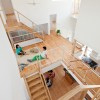A Thoroughly Modern Take on Shared Housing
A big focus is put on micro-apartments when talking about compact, efficient living. There’s good reason for this we believe. By and large, the world’s populations are consolidating in the cities with limited area to build; people are increasingly more interested in living in walkable areas; household sizes are dropping; there’s a growing lifestyle trend toward simplification and having less stuff. Micros support many, if not all of those aims, fitting more homes in less area, allowing people to live in amenity-rich, walkable areas, all while being greener, cheaper and easier to maintain than many of the status quo housing options. But there’s more than one way to go small, green and thrifty, and shared housing is definitely one of them.
Shared housing involves several unrelated people sharing a house (though a couple or family could live within a shared house) and they can operate like a normal family household, splitting chores, bills, shopping, food preparation and often extras like childcare and gardening.
Shared housing has myriad benefits. It can be extremely affordable. It can provide a rich and diverse cultural experience. By virtue of its small per person footprint, it can be very green.
But living in shared housing is definitely not for everyone, as anyone who has lived with roommates knows. Without house rules and adherence to them, living conditions can devolve with great alacrity. Imagine if one or two members stopped washing dishes for a week or stopped paying bills–it would quickly create messes and engender anger in the house members who abide by the rules.
The other thing that can turn people off of shared housing is their hodgepodge aesthetic qualities. They are often an assemblage of different people’s stuff and furniture, looking more like a third grade collage than a gesamtkunstwerk. While this doesn’t bother many, for others it’s a deal-breaker. They might want the shared living experience and benefits, but with a modern sheen–exactly what Tokyo’s “Share House” provides.
Share House was purpose-built for multiple unrelated residents. Designed by Japan’s Naruse Inokuma Architects, the 3200 sq ft home, while not small, is shared by 13 people, resulting in a mere 247 sq ft per person. The building has several separate communal spaces and 13 bedrooms, each measuring 77 sq ft. The ground floor offers a large communal area with kitchen, dining table and lounge. A floating mezzanine level and roofdeck provide two more common areas. By using a mezzanine rather than a separate floor, the space is kept open and grand with light flooding in from all directions–an architectural flourish you could not easily replicate in a micro-apartment.
The sparsely decorated space–at least in our opinion–is gorgeous. The ample use of natural wood with white walls make it feel clean and airy. At least in its pictured guise, there seems to be an agreement that residents not fill the place with a lot of their own furniture (we wonder if this was just for the photo shoot). What little furniture there is looks great and maintains a cohesive aesthetic.
Obviously, living successfully with others is far more than fancy design, and while we’re smitten with Share House’s aesthetic, we know little about its culture (living in it could be like an episode of the MTV’s The Real World). Nevertheless, it shows an alternative, and compelling, vision of what shared housing can be; a vision we believe might have wide appeal around the world.
[Note: A previous version of this article incorrectly referred to the Share House and cohousing. Cohousing refers to a intentional neighborhood made up of individuated houses that share activities, facilities and other community services. For more see the Cohousing Association of the United States]
Via Dezeen

















